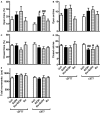Ro 15-4513 Antagonizes Alcohol-Induced Sedation in Mice Through αβγ2-type GABA(A) Receptors
- PMID: 21270945
- PMCID: PMC3026482
- DOI: 10.3389/fnins.2011.00003
Ro 15-4513 Antagonizes Alcohol-Induced Sedation in Mice Through αβγ2-type GABA(A) Receptors
Abstract
Ethyl alcohol (ethanol) has many molecular targets in the nervous system, its potency at these sites being low compared to those of sedative drugs. This has made it difficult to discover ethanol's binding site(s). There are two putative binding sites at γ-aminobutyric acid (GABA) type A receptor subtypes for the proposed ethanol antagonist Ro 15-4513, the established γ2 subunit-dependent benzodiazepine site and the recently reported δ subunit-dependent Ro 15-4513/ethanol binding site. Here, we aimed at clarifying the in vivo role of Ro 15-4513 at these two sites. We found that the antagonism of ethanol actions by Ro 15-4513 in wildtype mice was dependent on the test: an open field test showed that light sedation induced by 1.5-1.8 g/kg ethanol was sensitive to Ro 15-4513, whereas several tests for ethanol-induced anxiolytic effects showed that the ethanol-induced effects were insensitive to Ro 15-4513. Antagonism of ethanol-induced sedation by Ro 15-4513 was unaffected in GABA(A) receptor δ subunit knockout mice. By contrast, when testing the GABA(A) receptor γ2 subunit F77I knock-in mouse line (γ2I77 mice) with its strongly reduced affinity of the benzodiazepine sites for Ro 15-4513, we found that the ethanol-induced sedation was no longer antagonized by Ro 15-4513. Indeed, γ2I77 mice had only a small proportion of high-affinity binding of [(3)H]Ro 15-4513 left as compared to wildtype mice, especially in the caudate-putamen and septal areas, but these residual sites are apparently not involved in ethanol antagonism. In conclusion, we found that Ro 15-4513 abolished the sedative effect of ethanol by an action on γ2 subunit-dependent benzodiazepine sites.
Keywords: GABAA receptor; Ro 15-4513; alcohol antagonist; ethanol; inverse agonist.
Figures








Similar articles
-
Actions of two GABAA receptor benzodiazepine-site ligands that are mediated via non-γ2-dependent modulation.Eur J Pharmacol. 2011 Sep;666(1-3):111-21. doi: 10.1016/j.ejphar.2011.05.011. Epub 2011 May 19. Eur J Pharmacol. 2011. PMID: 21616065
-
Does ethanol act preferentially via selected brain GABAA receptor subtypes? the current evidence is ambiguous.Alcohol. 2007 May;41(3):163-76. doi: 10.1016/j.alcohol.2007.03.007. Alcohol. 2007. PMID: 17591542 Review.
-
Ethanol and the GABA receptor complex: studies with the partial inverse benzodiazepine receptor agonist Ro 15-4513.Pharmacol Biochem Behav. 1988 Nov;31(3):767-72. doi: 10.1016/0091-3057(88)90263-8. Pharmacol Biochem Behav. 1988. PMID: 2855121
-
The benzodiazepine/alcohol antagonist Ro 15-4513: binding to a GABAA receptor subtype that is insensitive to diazepam.J Pharmacol Exp Ther. 1991 Jun;257(3):1236-42. J Pharmacol Exp Ther. 1991. PMID: 1646328
-
Role of the GABA(A)beta2, GABA(A)alpha6, GABA(A)alpha1 and GABA(A)gamma2 receptor subunit genes cluster in drug responses and the development of alcohol dependence.Neurochem Int. 2000 Nov-Dec;37(5-6):413-23. doi: 10.1016/s0197-0186(00)00054-1. Neurochem Int. 2000. PMID: 10871693 Review.
Cited by
-
Removal of GABA(A) receptor γ2 subunits from parvalbumin neurons causes wide-ranging behavioral alterations.PLoS One. 2011;6(9):e24159. doi: 10.1371/journal.pone.0024159. Epub 2011 Sep 2. PLoS One. 2011. PMID: 21912668 Free PMC article.
-
Differential assembly diversifies GABAA receptor structures and signalling.Nature. 2022 Apr;604(7904):190-194. doi: 10.1038/s41586-022-04517-3. Epub 2022 Mar 30. Nature. 2022. PMID: 35355020 Free PMC article.
-
α4-Containing GABA(A) Receptors are Required for Antagonism of Ethanol-Induced Motor Incoordination and Hypnosis by the Imidazobenzodiazepine Ro15-4513.Front Pharmacol. 2011 Apr 4;2:18. doi: 10.3389/fphar.2011.00018. eCollection 2011. Front Pharmacol. 2011. PMID: 21779248 Free PMC article.
-
Ethanol→Nicotine & Nicotine→Ethanol drug-sequence discriminations: Conditional stimulus control with two interoceptive drug elements in rats.Alcohol. 2019 Jun;77:125-134. doi: 10.1016/j.alcohol.2018.10.012. Epub 2018 Nov 5. Alcohol. 2019. PMID: 30408489 Free PMC article.
-
Structural models of ligand-gated ion channels: sites of action for anesthetics and ethanol.Alcohol Clin Exp Res. 2014 Mar;38(3):595-603. doi: 10.1111/acer.12283. Epub 2013 Oct 24. Alcohol Clin Exp Res. 2014. PMID: 24164436 Free PMC article. Review.
References
-
- Becker H. C., Hale R. L. (1989). Ethanol-induced locomotor stimulation in C57BL/6 mice following RO15-4513 administration. Psychopharmacology (Berl.) 99, 333–336 - PubMed
-
- Becker H. C., Hale R. L. (1991). RO15-4513 antagonizes the anxiolytic effects of ethanol in a nonshock conflict task at doses devoid of anxiogenic activity. Pharmacol. Biochem. Behav. 39, 803–807 - PubMed
-
- Belzung C., Misslin R., Vogel E. (1988). Does RO 15-4513 reverse the anxiolytic effects of ethanol by its intrinsic properties? Pharmacol. Biochem. Behav. 30, 867–870 - PubMed
LinkOut - more resources
Full Text Sources
Research Materials

